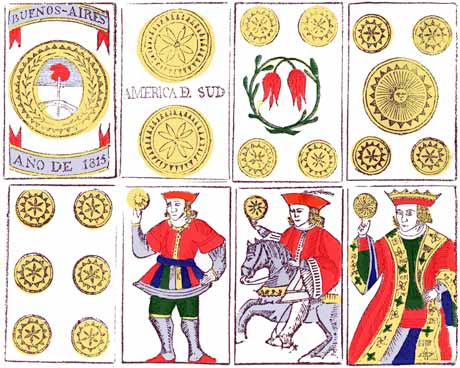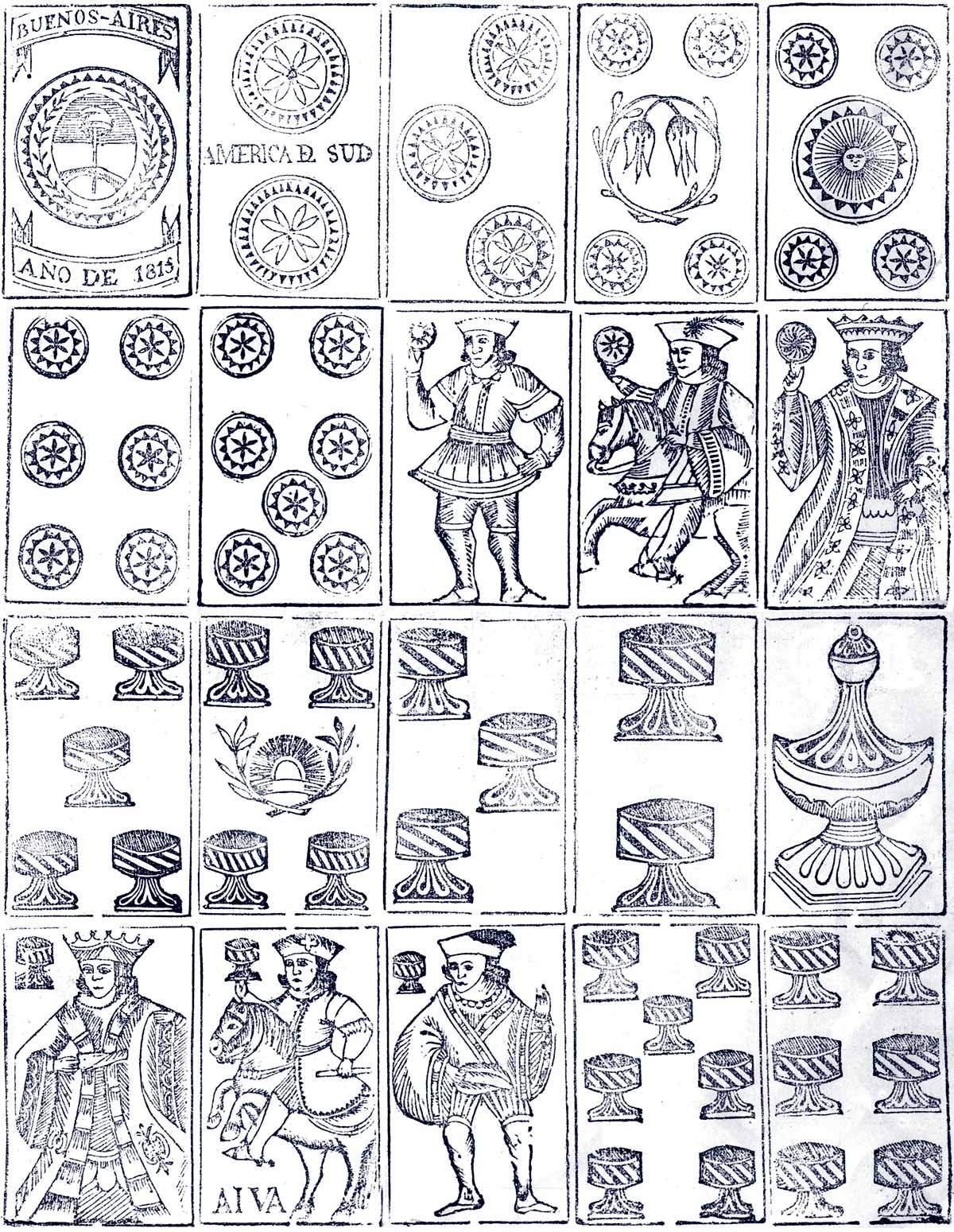J. M. Gandarillas, Buenos Aires, c.1815
Playing cards believed to have been designed in 1815 by the Chilean immigrant Manuel José Gandarillas in Buenos Aires and published the following year.

Manuel José Gandarillas
The illustration below shows a sheet (uncoloured and anonymous) of playing cards believed to have been designed in 1815 by the Chilean immigrant Manuel José Gandarillas in Buenos Aires and published the following year. The style of the cards closely follows the Spanish "National" pattern, but with local symbolism added to several cards, e.g. the flower on the four of coins is Argentina's national flower, 'flor del seibo'.
Close examination of the drawings in Gandarillas' pack shows that although he was closely following the typical Spanish "National" pack of the day, or even that of a few decades earlier, nevertheless, some idiosyncrasies or deviations can be identified in the designs.

The ace of coins features the Argentinean coat-of-arms, which had been ratified at the Constitutional General Assembly in 1813. In 1815 Buenos Aires was only a province of the River Plate region, occasionally spelt "Buenos Ayres", (and hyphenated in our example). It did not become the capital city of the Republic of Argentina until 1882.
The laurel wreath on the four of cups symbolises liberty and The Independence (from Spanish government) is represented by the rising sun. The two of coins bears the words "America del Sud": at this time there was a movement for a South American Republic (República de Sud América), involving national heroes such as Simón Bolivar and General San Martín. The final outcome was the diverse collection of individual countries existing today. The sun shown on the five of coins is the sun found on the Argentinean national flag.
Images courtesy of Dra. Graciela Bercoff, curator of the Archivo General de la Nacion, Buenos Aires.
See also: Spanish Playing Cards • Phelippe Ayet • Baraja Morisca • History of Playing Cards • Seville 17th Century • Spanish National Pattern • The Money Bag pattern • Pedro Bosio • Gothic Spanish-Suited Cards • Rotxotxo Inventories • Navarra XVII Century • Quercia y Possi • Naipes Artiguistas • Macharaviaya • Francisco Flores • 16th Century 'Rimac' Cards • Spanish-suited playing cards made in Germany • Joan Barbot • Simon Wintle's Spanish-Suited pack • Anabella Corsi's Naipes La Criolla

By Simon Wintle
Member since February 01, 1996
I am the founder of The World of Playing Cards (est. 1996), a website dedicated to the history, artistry and cultural significance of playing cards and tarot. Over the years I have researched various areas of the subject, acquired and traded collections and contributed as a committee member of the IPCS and graphics editor of The Playing-Card journal. Having lived in Chile, England, Wales, and now Spain, these experiences have shaped my work and passion for playing cards. Amongst my achievements is producing a limited-edition replica of a 17th-century English pack using woodblocks and stencils—a labour of love. Today, the World of Playing Cards is a global collaborative project, with my son Adam serving as the technical driving force behind its development. His innovative efforts have helped shape the site into the thriving hub it is today. You are warmly invited to become a contributor and share your enthusiasm.
Related Articles

Visite Mexico
Promoting Mexican tourism with 54 different photographs in full colour.

Jockey Club de Buenos Aires
Spanish-suited pack by Chas Goodall & Son Ltd for the Jockey Club, Buenos Aires.

Catalan pattern by B.P Grimaud
Standard Spanish Catalan pattern deck made in Paris by B.P Grimaud.

Archaic Spanish proof sheets
2 x uncoloured proof sheets of archaic Spanish-suited playing cards produced for “New Spain”, possib...

Peintres Latino Americains
Original artwork by 18 different Latin American artists.

Pere Pau Rotxotxo Puigdoura
Spanish national pattern by Pere Pau Rotxotxo Puigdoura (1766–1797).

P. Buscaglia: Spanish-suited cards
Spanish-suited cards published by P. Buscaglia, Mele & Genova.

B.P. Grimaud pack for Bolivia
Spanish-suited pack made in France for sale in Bolivia, c.1880.

South American Costumes
Costumes of people of Brazil, Peru and Mexico, with views of Rio de Janeiro on the aces.

Félix Solesio e Hijos
Félix Solesio e Hijos - Real Fábrica de Madrid - Spanish National pattern for Venezuela

Juan de Brugada
Spanish National pattern by Juan de Brugada e hijo, Real Fábrica de Madrid, 1821.

Parisian Spanish pattern by Fossorier, Amar et Cie
‘Parisian’ Spanish pattern published by Fossorier, Amar et Cie (Paris), c.1902.

“Abd-el-Kader” by Fossorier, Amar et Cie for Algeria
Spanish National pattern produced by Fossorier, Amar et Cie (Paris) for Algeria, around 1902.

Félix Solesio e Hijos
Félix Solesio e Hijos, Fábrica de Macharaviaya, Spanish National pattern for West Indies, 1801.

Naipe de Bridge
Standard English pattern pack made in Ecuador, c.1970.

Christopher Columbus 5th Centenary playing cards
Fifth Centenary of the Discovery of America playing cards by published by Heraclio Fournier.
Most Popular
Our top articles from the past 28 days

